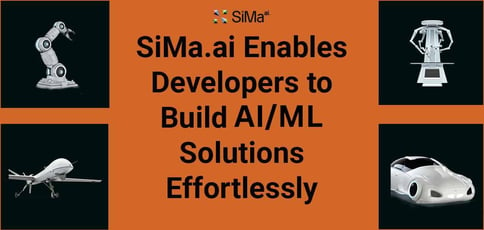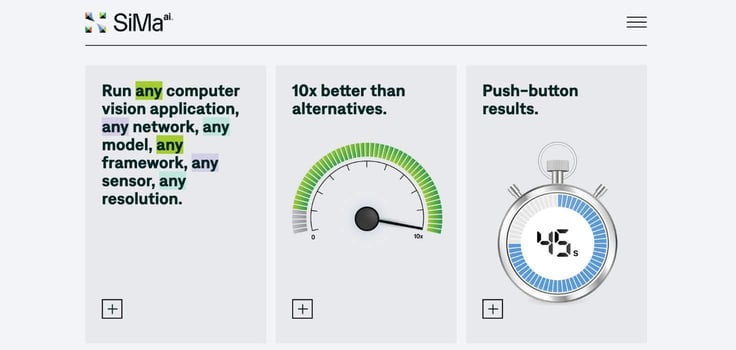
TL; DR: SiMa.ai provides a holistic ML development platform that provides hardware and software solutions. Its mission is to make ML development as effortless as possible for developers, and its drag-and-drop programming environment is one of the main ingredients behind its value proposition. Users can create, build, and deploy applications in less time while increasing power efficiency and performance. We spoke with Alicja Kwasniewska, Senior Principal ML Architect of SiMa.ai, about the platform and its unique benefits.
Taking on the complexities of AI/ML scaling is not for the faint of heart. Developers have to navigate and meet the endless requirements of ML systems before reaching the finish line. This entails weaving several blocks of the ML system together to create a solution, from neural networks and application logic to control flow and data integration.
While some companies are racing to create their own AI/ML solutions, others are seeking to help democratize the development journey. As artificial intelligence rapidly evolves, teams will need tools to help them stay on track and complete their work cycles.
In pursuit of making ML effortless for developers, SiMa.ai helps teams overcome steep learning curves and claim the benefits of ML in less time. Over the years, SiMa.ai has gathered feedback from its industry-leading customers to better understand the challenges of AI/ML workflows and create dev tools to solve those pain points.

“Most systems are fairly complex beasts. So you need a solution that will be able to address all of this. With our software, we offer preoptimized kernels, so that you can plug and play and combine all of these blocks,” said Alicja Kwasniewska, Senior Principal ML Architect of SiMa.ai.
SiMa.ai offers software and hardware solutions at the edge to help developers along their work cycle. Everything from its software to infrastructure is purpose-built for ML development, meaning users get to work with a platform tailored to their ML needs and create highly efficient solutions.
In Pursuit of Simplifying AI/ML Development
Being a software-centric company allowed SiMa.ai to prioritize ease of use and power efficiency. Its main product, Palette, is the epitome of its mission.
“Palette’s name comes from a vision that we wanted to provide to our customers that said of effortless, easy-to-use tools that will cover the entire color spectrum of their needs,” said Alicja.
SiMa.ai understands the challenges developers face to integrate ML into their products, whether that’s a self-driving car or a drone. That’s why its solutions are purpose-built for ML and not adapted for it. SiMa.ai’s Palette software, along with its MLSoC silicon, offers a low-code, command line, and integrated environment for users to easily build and deploy their applications.
Its Palette Edgematic solution is another game changer. Catering to the masses, Palette Edgmatic’s no-code, drag-and-drop programming environment democratizes ML for every type of developer. “It allows you to drag and drop different blocks, combine them into a complex pipeline, and then deploy a solution in minutes,” said Alicja.
SiMa.ai transforms the developer work cycle by simplifying it. It covers the entire application life cycle and meets every ML system’s requirements.
“The only thing a user has to worry about is loading the model. It doesn’t matter what framework they use. So the user loads the model, and then all the magic will happen underneath. We also load the latest model topologies and can quickly prototype with them,” said Alicja.
A Holistic Solution for Hardware and Software Needs
SiMa.ai is a software-centric company. The team wanted to provide users with a quality, future-proof software solution at a time when only a sea of hardware product options existed. Alicja told us there was a surplus of hardware on the market, but most of those products didn’t have software conducive to keeping up with the fast evolving AI domain.
“Future-proof software was one of our key pillars from day zero. Software is the key for developers to be successful and to be able to scale. So we took that approach from the software perspective, but we also realized there was no purpose-built hardware solution,” said Alicja.
Its hardware solution, MLSoC, helps users deploy and scale ML applications at the embedded edge. Because SiMa.ai offers heterogeneous compute, developers can complete all blocks of the ML systems on a single MLSoC chip.

“Before designing, we had to think about doing a hardware and software co-design and develop a solution that will allow for high efficiency but at the same time low power consumption,” said Alicja.
MLSoC provides a clear and tailored platform for ML development at the edge. SiMa.ai uses a unique blend of industry-standard interfaces, specialized computer vision, and machine-learning acceleration processors to create this solution. SiMa.ai goes beyond ML accelerators and silicon-centric approaches to give users a complete and easy-to-use platform.
SiMa.ai works with several resource-intensive and privacy-first industries, including government, healthcare, and automotive. So having a solution at the edge not only provides power efficiency but also data privacy.
“We ensure models behave the same way during the development and production because there is no room for changes. We also prioritize transparency. You can’t have a black box solution because customers need to know what happened to their models to certify and support it,” said Alicja.
Getting Ahead of New Trends
SiMa.ai’s hardware and software design structure has given the company a solid foundation for development. Alicja said no real changes are coming to the fundamental portion of the platform, but the team is working on a new generation of products to enhance their solutions.
“We are looking into large multimodal enablement because we believe having the ability to make use of all these senses, where you combine audio, vision, text, and emotions, to make intelligent predictions is the key to having smart devices,” said Alicja.
SiMa.ai’s ML solutions already pair well with the robotics industry’s needs. But SiMa.ai seeks to elevate these capabilities further by enabling large language models. An LLM solution will also help it meet the demand for this new trend.
“Imagine a robot that can take inputs from different sensors but also take inputs from the region, like how people around it behave, and then dynamically adjust to the current situation and take action. That would be life-changing for the industry. So that’s what we are trying to do,” said Alicja.
The SiMa.ai team will also attend the Embedded World conference in 2024 to display its hardware and software technology. Alicja invites users to connect with the sales team to test the platform and see how the drag-and-drop functionality works. Anyone can try out SiMa.ai’s platform, whether you’re at the conference or not.


